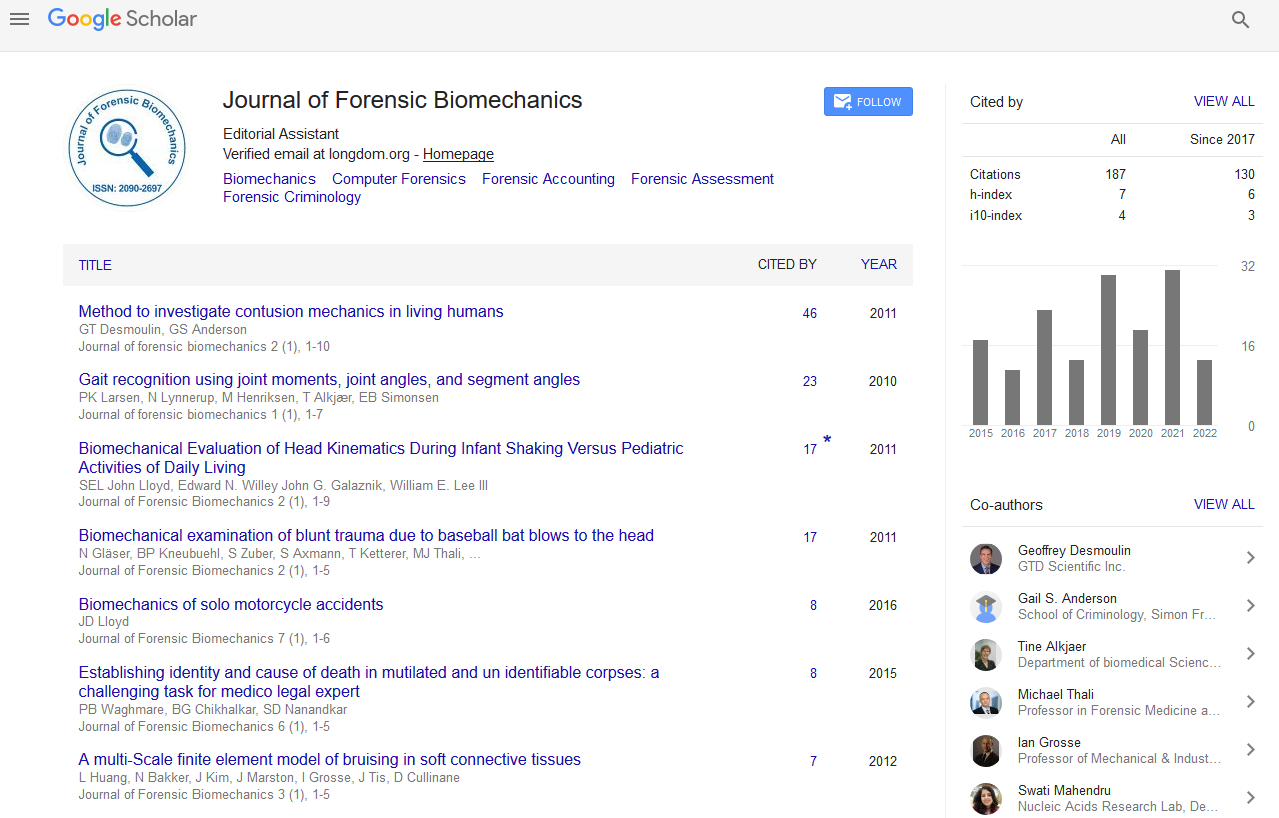Indexed In
- Genamics JournalSeek
- SafetyLit
- Ulrich's Periodicals Directory
- RefSeek
- Hamdard University
- EBSCO A-Z
- Geneva Foundation for Medical Education and Research
- Euro Pub
- Google Scholar
Useful Links
Share This Page
Journal Flyer

Open Access Journals
- Agri and Aquaculture
- Biochemistry
- Bioinformatics & Systems Biology
- Business & Management
- Chemistry
- Clinical Sciences
- Engineering
- Food & Nutrition
- General Science
- Genetics & Molecular Biology
- Immunology & Microbiology
- Medical Sciences
- Neuroscience & Psychology
- Nursing & Health Care
- Pharmaceutical Sciences
Research Article - (2024) Volume 15, Issue 4
Impact Performance Comparison of Type II Safety Helmets with and without Dedicated Mechanisms for Brain Protection
Michael Bottlang*, Stanley Tsai, Tristan Miller and Steven MadeyReceived: 01-Oct-2024, Manuscript No. JFB-24-27091; Editor assigned: 03-Oct-2024, Pre QC No. JFB-24-27091 (PQ); Reviewed: 17-Oct-2024, QC No. JFB-24-27091; Revised: 24-Oct-2024, Manuscript No. JFB-24-27091 (R); Published: 31-Oct-2024, DOI: 10.35248/2090-2697.24.15.509
Abstract
The latest generation of safety helmets features improved impact liners to meet Type II lateral impact requirements of standard ANSI Z89.1. Several manufacturers have also introduced technologies to dampen rotational forces known to cause brain injury. This study evaluated the impact performance of these novel helmets.
Seven Type II-rated helmets were tested, four of which included technologies for brain protection from rotational forces, namely Impact Armor, MIPS, Koroyd and WaveCel. Impact performance was tested in three scenarios: lateral impacts according to ANSI Z89.1, crown impacts according to EN-12492 and oblique impacts representative of falls. For lateral impacts, a helmeted headform was dropped onto an anvil with 31 J impact energy, impacting the helmet front, side and back to assess impact acceleration. For crown impacts, a striker was dropped onto the helmet crown at 96 J impact energy to assess impact force transmission. For oblique impacts, a Hybrid III head-neck surrogate was dropped onto a 45° anvil with 274 J impact energy to assess headform linear and rotational kinematics.
In lateral impacts, impact accelerations differed over 2-fold between helmets and three helmets exceeded the 150 g threshold specified by ANSI. In crown impacts, impact force transmission differed over 3-fold between helmets and two helmet models exceeded the 10 kN threshold specified by EN 12492. In oblique impacts, two technologies proved effective in reducing the transmission of rotational forces.
Significant differences in helmet impact performance exist. The results of this study can inform helmet selection and optimization by evidence-based numerical guidance.
Keywords
Safety helmet; Construction; Type II; Brain injury; Concussion; Impact testing
Introduction
Each year, over 50,000 work-related non-fatal head injuries are admitted to hospitals in the United States [1]. These non-fatal head injuries can be life-altering events, whereby only 16% of Traumatic Brain Injury (TBI) patients achieve a complete return to work after 12 months [2], while 45% of TBI patients are not attending ordinary work for five years after their injury. The economic burden associated with a single work-related TBI typically exceeds $1 million [3]. The construction industry faces the highest number of occupational TBIs of any industry in the US, accounting for 25% of all work-related TBIs [4].
There are two distinctly different types of head injury, namely brain injury and skull fracture. Skull fractures are typically caused by a blunt force, such as the impact from a falling object that is simulated by vertical drop testing in standardized tests for safety helmets [5,6]. The hard outer shell of a helmet aims to distribute the focused impact over a larger area to prevent skull fracture. In contrast to skull fractures, brain injury is primarily caused by the rotational force acting on the head during impacts from slips, trips and falls [7]. A wealth of research has demonstrated that a short yet forceful twist of the head during impact can strain and shear the soft brain tissue, causing brain injury ranging from a mild concussion to severe TBI [7-12]. Slips, trips and falls are responsible for 68% of all work-related TBI cases in the construction industry, while falling objects cause only 12% of work-related TBI [13]. Over 90% of brain injuries occur in absence of a skull fracture which further confirms that the soft brain is injured by a distinctly different mechanism than the hard skull [14]. This critical vulnerability of the brain to rotational forces is not yet considered in standardized helmet tests. However, test methods to include rotational acceleration are being prepared by helmet standard committees in North America (ASTM draft proposal WK72409) and in Europe (WG 11 standard) and have been used in research laboratories for over a decade to predict brain protection provided by helmets [15-18].
Two test standards are primarily used for assessment of impact performance of safety helmets, namely the American National Standard for Industrial Head Protection, ANSI/ISEA Z89.1- 2014 and the European Standard EN 12492 for “Helmets for Mountaineers” [5,6]. The ANSI standard entails two levels of impact protection: Type I helmets are only tested for their ability to dampen straight impacts to the top of the helmet; Type II helmets are in addition tested for their ability to dampen impacts of the helmet front, side and rear. An ANSI Type II rating provides improved real- world protection since only a quarter to a third of impacts occur to the top of the helmet, while 52% to 62% of impacts occur from lateral to the helmet front, side and rear. This ANSI standard is applicable for traditional hard hats and more recent climbing- style safety helmets. Many climbing-style safety helmets are also certified to the European Standard EN 12492 [5]. Similar to the ANSI Z89.1 Type II standard, EN 12492 requires impact testing to the helmet crown and sides. Crown impact testing is more stringent in EN 12492, which requires a 78% higher impact energy of 98 J compared to the ANSI requirement of 55 J (Table 1 and Figure 1). Conversely, lateral impact testing is more stringent in ANSI Z89.1. It requires a 24% higher energy of 31 J for lateral impacts compared to 25 J in the EN 12492 standard. ANSI Z89.1 also prescribes a hemispherical impactor, which causes a more focused impact concentration compared to the flat impactor of EN 12492. Finally, lateral impacts in ANSI Z89.1 are conducted lower to the helmet brim compared to EN 12492, requiring a broader coverage of the impact liner. The most stringent helmet performance assessment is therefore provided by evaluating crown impacts according to EN 12492 and lateral impacts according to ANSI Z89.1.
| Comparison of impact test requirements | ANSI Z89.1 | EN12492 | |
|---|---|---|---|
| Crown impact | Energy | 55 J | 98 J |
| Drop height | 1.5 m | 2 m | |
| Location | crown | Crown | |
| Anvil shape | Hemisphere, r=48 mm | Hemisphere, r=50 mm | |
| Lateral impact | Energy | 31 J | 25 J |
| Drop height | 0.6 m | 0.5 m | |
| Location | Above Dynamic Test Line (DTL) | 30ᵒ from reference plane flat | |
| Anvil shape | Hemispherical, r=48 mm | flat | |
Table 1: Comparison of impact test requirements between ANSI Z89.1 and EN 12492 standards.
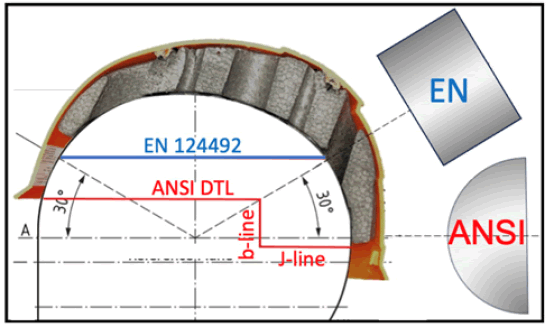
Figure 1: Difference in lateral impact locations between ANSI and EN standards.
A recent study evaluated 14 different safety helmet models by combined EN 12492 testing for crown impacts and ANSI Type II testing for lateral impacts, reporting up to five-fold differences in crown impact absorption and up to four-fold differences in lateral impact performance [19]. They found that none of the climbing- style safety helmets sold by leading helmet manufacturers in 2021 met ANSI Type II requirements. However, their study did not include the latest generation of Type II safety helmets that have been introduced by leading helmet manufacturers to accommodate the requirements of large contractors for Type II certified head protection [20]. Several of these latest safety helmets also claim to improve absorption of rotational forces to reduce brain injury risk by various means. As described by their manufacturers, these strategies include IMPACT ARMOR super polymer foam that stiffens under force to prevent transmission of oblique forces, MIPS slip liners to redirect rotational forces, KOROYD welded tubes that protect the skull and brain from both direct and angled impacts and a WaveCel dome with cells that fold and translate to absorb rotational energy. In addition, one manufacturer introduced an in-house oblique impact test WG11 to support rotational impact performance of their helmets. These emerging technologies for brain protection combined with the latest generation of Type II certified safety helmets may hold considerable potential to reduce the incident and severity of head injury. Timely performance testing of these new helmets over a range of impact conditions is therefore crucial to determine their efficacy under well-defined and reproducible test conditions.
This study measured for the first time the impact performance of the latest generation of Type II helmets from leading manufacturers. It combined EN 12492 testing for crown impacts and ANSI Type II testing for lateral impacts. In addition, it employed a well-established oblique impact test to assess absorption of rotational forces known to induce brain injury from slips, trips and falls. Results of this research can therefore provide critical numerical evidence on helmet performance over a range of impact conditions that can help to inform helmet selection and future design optimization.
Materials and Methods
Seven safety helmet models with an ANSI Z89.1, Type II rating for crown and side impact protection were tested to evaluate their impact absorption performance in three distinct scenarios: Lateral impacts according to ANSI Z89.1 [6], crown impacts according to EN 12492 [5], and oblique impacts representative of a fall [17]. Lateral and crown impacts were assessed in terms of the peak linear acceleration and force during impact, respectively, to assess the risk of skull fracture. Oblique impacts representative of a fall were assessed in terms of peak rotational head acceleration to predict brain injury risk. All helmet tests were conducted at the Helmet Impact Testing (HIT) facility at the Legacy Research Institute in Portland, Oregon, USA. All testing was conducted under ambient conditions, defined according to the ANSI Z89.1 standard to be 23°C ± 3°C and 50% ± 5% relative humidity [6].
Helmets
Seven different type II-certified helmet models were selected from five leading helmet manufacturers (Table 2 and Figure 2). Two of these manufacturers offered the same helmet design with or without rotational impact damping technology for added brain protection, allowing a direct assessment on the relative contribution of these two technologies. The Milwaukee Tool Company (Brookfield, WI) offers the Bolt Type II (group BOLT) and Bolt Type II with Impact Armor technology (group BOLT IA). Impact Armor is a 10 mm thick impact absorbing foam insert made of RheonTM material that stiffens at higher rates of deformation to increase energy dissipation in impacts. According to the manufacturer, it is intended to prevent transmission of oblique impact forces to the brain to reduce the risk of TBIs from slips, trips and falls. MSA Safety (Cranberry Township, PA) offers the V-Gard H2 (group V-Gard) and V-Gard H2 with MIPS (group V-Gard MIPS). The MIPS brain protection system is a 1 mm thick plastic sheet inside the helmet. According to its manufacturer, it is designed to slip slightly during impact to redirect rotational forces from slips, trips and falls in order to help reduce the risk of TBI. Two other manufacturers only offer type II helmets with brain protection since their technology is an integral part of the helmet impact liner. Studson (Tigard, OR) offers the SHK-1 (group SHK-1) with Koroyd technology. Koroyd is a 15 mm thick honeycomb material made of welded tubes that is inserted into pockets of a foam impact liner to enhance energy absorption. According to the manufacturer, it shields the skull and brain from both direct and angled impacts. WaveCel (Wilsonville, OR) offers the T2+ MAX (group T2+) with WaveCel technology. It consists of a 15 mm thick hemispherical dome made of a collapsible cellular structure, whereby each cell has a crease that allows cells to fold in the axial and shear direction to absorb linear and rotational forces. This cellular dome can deform under axial and shear forces and slip inside the helmet shell to maximize absorption of rotational energy. The fifth helmet manufacturer (Kask America Inc., Charlotte, NC) offers the Zenith X2 (group ZENITH X2). This helmet does not have a dedicated rotation damping technology but has passed an oblique impact test trademarked by Kask as “Rotation impact WG11 test passed”. This test employs a 4.5 m/s impact of a free- falling headform onto a 45° anvil with an impact energy of 51 J. This Kask WG11 test is not to be confused with the European Committee for Standardization (CEN) Working Group 11 that is establishing a standard for oblique impact testing of helmets.
| Group | BOLT | BOLT IA | V-Gard | V-Gard MIPS | SHK-1 | T2+ | Zenith X2 |
|---|---|---|---|---|---|---|---|
| Manufacturer | Milwaukee | MSA | Studson | WaveCel | Kask | ||
| Model | Bolt | Bolt Impact armor | V-Gard H2 | V-Gard H2 MIPS | SHK-1 | T2+ MAX | Zenith X2 |
| Rot. Damping Tech. | Non | Impact armor | Non | MIPS | KOROYD | WaveCel dome | WG 11 rotation tested |
| ANSI Z89.1. Impact rating | Type II, Class C | Type II, Class C | Type II, Class C | Type II, Class C | Type II, Class C | ||
| EN 12492 Impact rating | Partial compliance: Excludes clause 4.2 1.1: Crown impact | Partial compliance: Excludes clause 4.2 1.1: Crown impact | Partial compliance: Excludes clause 4.2 1.1 | Full compliance | Partial compliance: Excludes clause 4.2 1.1 | ||
| Style | Climbing style | climbing style | Climbing style | Full-Brim | Climbing style | ||
| Size | 52-68 cm | 53-63 cm | 53-59 cm (Medium/Large) | 53-63 cm | 52-63 cm | ||
| Weight | 526 g | 588 g | 519 g | 552 g | 554 g | 534 g | 468 g |
| Shell material | HDPE | ABS | ABS | ABS | HDPP | ||
| Impact liner | Expanded Polystyrene (EPS) foam | Expanded Polystyrene (EPS) foam | EPS foam, KOROYD | Open cell matrix | EPS foam | ||
Table 2: Description of the seven Type II-rated helmets for testing, four of which had a dedicated rotation damping technology to help mitigate brain injury.
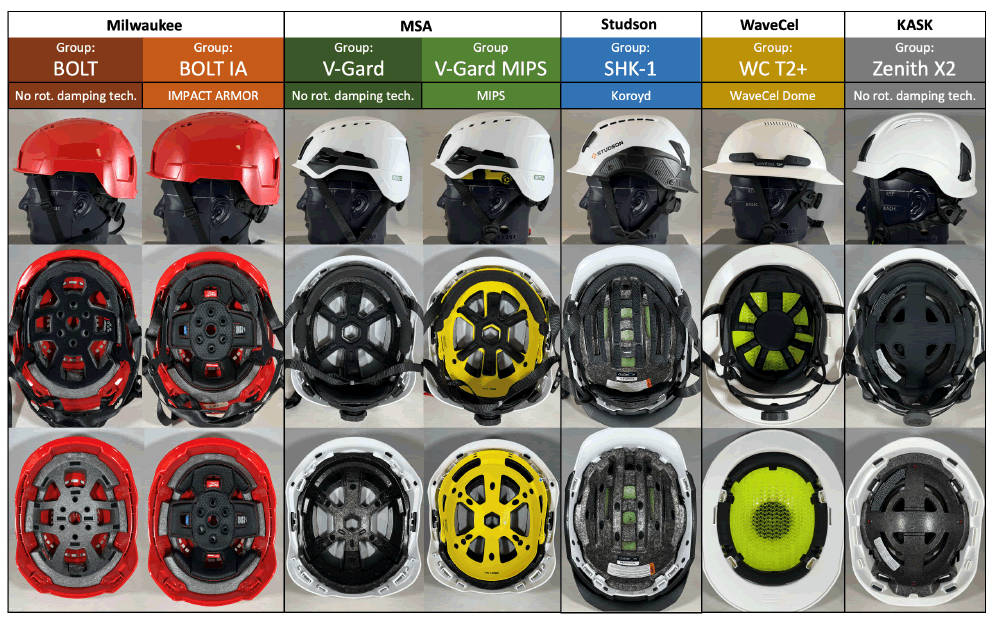
Figure 2: Seven Type II-rated helmets, four of which had a dedicated rotation damping technology. The third row of images depicts inside views of helmets after removing the comfort liner, fit system, and chin strap to better visualize the impact liner.
These seven different type II-rated helmets were tested in lateral impacts to the front, side and rear (n=3), in crown impacts (n=3) and in oblique impacts (n=3), requiring a total of 105 impact tests on 42 helmets.
Lateral impact testing
Attenuation of lateral impacts to the front, side and back of the helmet were evaluated in accordance to standard ANSI/Z89.1-2014 by dropping a helmeted headform onto a hemispherical impact anvil [6]. An ISO size J headform with a Shore “D” durometer of 60 (SB070, Cadex Inc., Quebec, Canada) was mounted to the drop assembly of a vertical drop rail (Figure 3A). The combined weight of the headform and drop assembly was 5.0 kg. A ball joint inside the headform allowed adjustment of headform orientation for front, side and rear impacts. ANSI standard Z89.1 requires that the edge of the hemispherical anvil with 48 mm radius does not overlap with the Dynamic Test Line (DTL). The DTL was marked on helmets with a laser level after helmets were firmly seated onto the ISO size J headform and loaded with a 50 N static force according to standard ANSI Z89.1-2014. The locations of front impacts (Figure 3B), side impacts (Figure 3C) and rear impacts (Figure 3D) were marked to be 48 mm superior to the DTL. All front and rear impact were conducted at the midsagittal plane passing through the helmet center. Side impacts were marked 48 mm above the “j line” and 48 mm posterior to the “b line” of the DTL as defined in the ANSI standard. This consistent side location generally corresponds with the mounting position of the fit system side arms inside the helmet. This position was selected to comply with ANSI instruction that if there are internal projections inside the helmet above the DTL, the helmet shall be impacted directly on the projection (Figure 3).
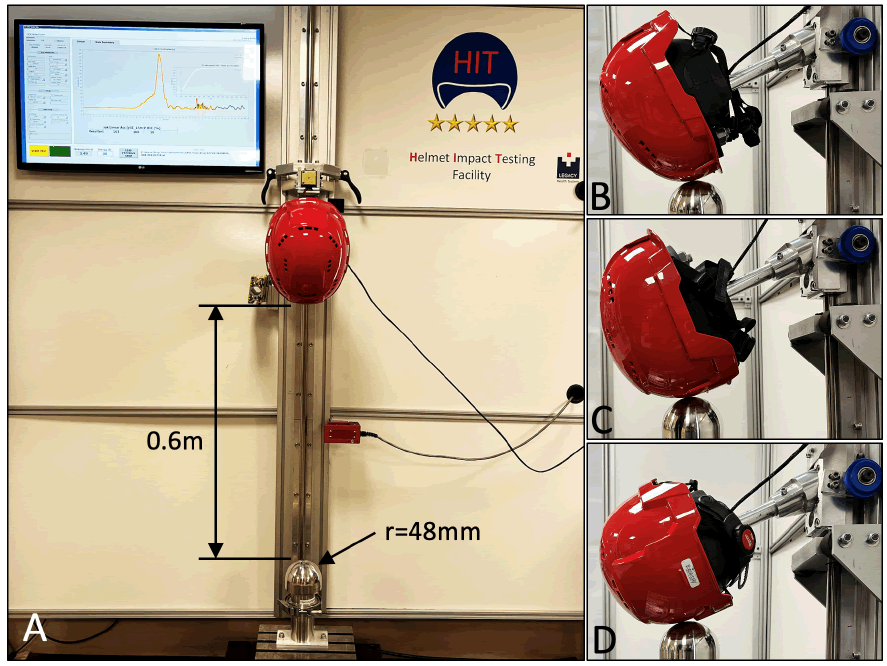
Figure 3: Lateral impact testing at 31 J impact energy according to ANSI Z89.1. Note: A) A helmeted headform is released from 0.6 m height onto a hemispherical impactor; B) The headform is rotated around a ball joint to achieve front impacts; C) The headform is rotated around a ball joint to achieve rear impacts; D) The headform is rotated around a ball joint to achieve front side.
For impact testing, helmeted headforms were subjected to guided free fall from a nominal drop height of 0.6 m to achieve an impact speed of 3.5 m/s, representing an impact energy of 31 J. Impact speed νFRONT, νSIDE and νREAR for front, side and rear impacts, respectively, was measured with a timed light gate (#5012 Velocimeter, Cadex Inc., Quebec, CA) located 5 mm above the point of impact. Drop tests were conducted onto a hemispherical anvil with 48 mm radius that was rigidly mounted on a 150 kg steel base. Linear acceleration of the headform during impact was measured with a linear accelerometer (356B21, PCB, Depew, NY) mounted at the center of gravity of the headform and oriented to capture acceleration along the impact direction. Linear acceleration signals were captured at a sampling rate of 20 kHz in a data acquisition system (PCI-6221, National Instruments, Austin, TX). Three helmets of each helmet model were impacted in accordance with ANSI standard Z89.1- 2012 onto the front, side and rear, locations to measure the peak linear accelerations aFRONT, aSIDE and aREAR, respectively. The ANSI standard requires that the peak acceleration shall not exceed 150 g.
Crown impact testing
The shock absorption of impacts to the helmet crown was evaluated in accordance to standard EN 12492:2012, section 4.2.1.1 by dropping a hemispherical striker onto a helmeted headform (Figure 4), [5]. For this test, helmets were seated on an ISO size J magnesium headform (100_04_HMH, Cadex Inc., Quebec, Canada) mounted to the base of a vertical drop tower. The headform was attached to an impact force measurement system (DI-1000UHS, Loadstar Systems, Fremont, CA) to capture the impact force transmitted to the headform at a frequency of 10 kHz. A 5 kg hemispherical steel striker with a 50 mm radius was released from a drop height of 2 m and guided with a mono-rail guide system to impact the crown of the helmet. Impact speed νCROWN was measured with the timed light gate located 5 mm above the point of impact. The peak impact force FCROWN was extracted after 600 Hz low pass filtering of the impact force signal, as required by EN 12492. The EN standard requires that FCROWN must remain below 10,000 N.
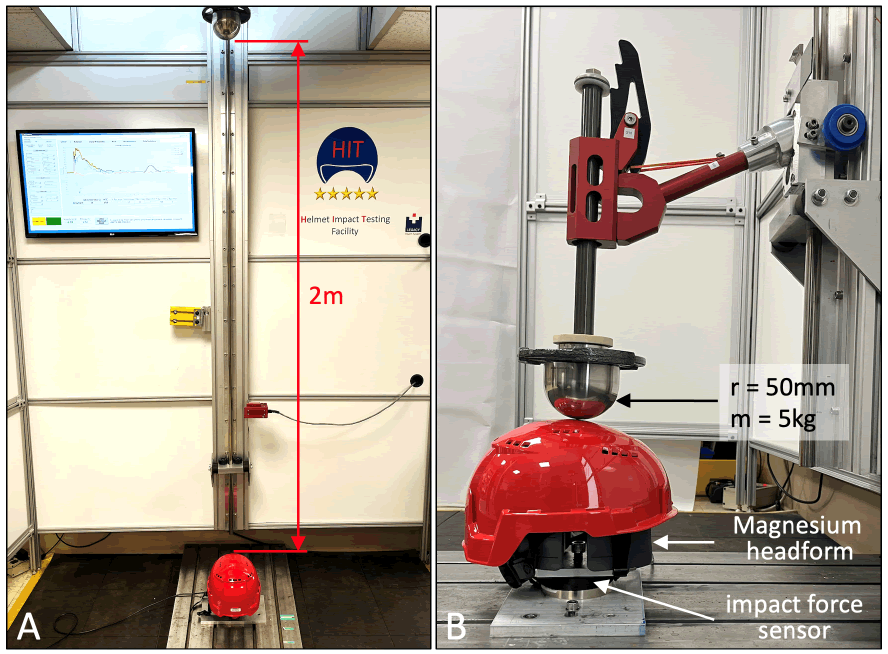
Figure 4: Crown impact testing at 98 J impact energy according to EN 12492. Note: A) A hemispherical impactor is release from 2 m height onto the crown of the helmet; B) The impact force is measured at the base of the headform.
Oblique impact testing representative of falls
Impacts representative of falls were tested according to an established protocol that has been successfully used by different research laboratories to determine differences in impact performance of bicycle, snow sport and construction helmets [16,18,21-23]. This protocol employed a Hybrid III 50th percentile male anthropomorphic head and neck surrogate (78051-336, Humanetic Innovative Solutions, Plymouth, MI) connected to a vertical drop tower rail (Figure 5). The weight of the drop assembly was 14.3 kg, including the Hybrid III head and neck surrogate and its structural connection to the drop rail.
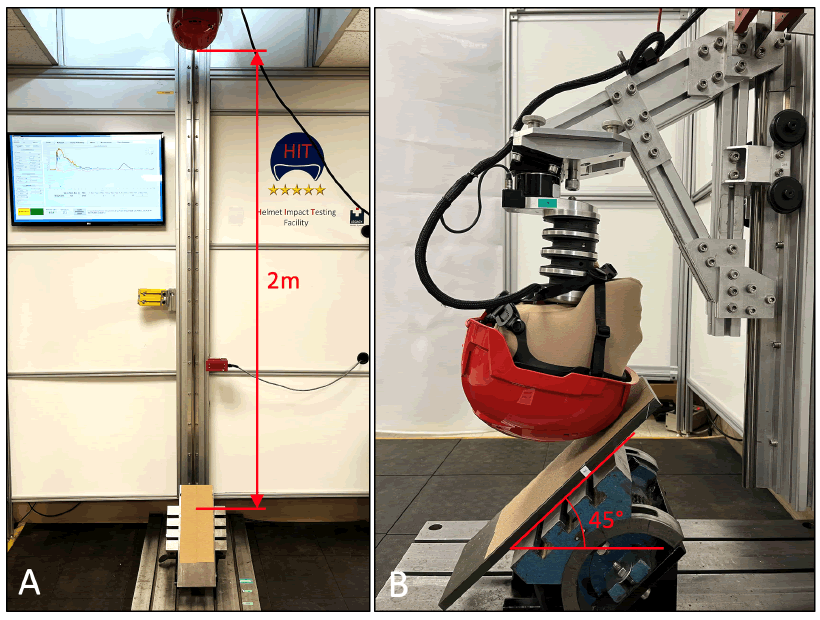
Figure 5: Oblique impact testing. Note: A) Helmet testing with 275 J impact energy at 6.2 m/s impact speed onto a 45° tilted anvil; B) An instrumented Hybrid III head and neck surrogate captured linear and rotational headform kinematics.
A flat anvil was positioned at a 45 angle relative to the horizontal plane to induce an oblique impact in response to a vertical drop. This 45 angle was selected to match previously published studies on oblique impact testing of helmets [18,23-26]. It also corresponds to the proposed test methods of the European CEN Working Group 11 and the in-house tests of several helmet manufacturers, including Kask and Milwaukee. Linear and rotational accelerations of the headform were captured with a six-degrees-of-freedom sensor package (6DX Pro, DTS Inc., Seal Beach, CA) containing three linear accelerometers and three angular rate sensors. This miniature sensor package was mounted at the center of gravity of the Hybrid III head. The resultant linear acceleration aR was calculated from the three linear acceleration components. The resultant rotational acceleration αR of the headform was calculated by differentiation of the three angular rate signals ωX, ωY and ωZ. Since the silicone skin surrogate of the Hybrid III headform has over twice the surface friction coefficient of the human head [27], a nylon stocking was fitted over the Hybrid III headform to reduce surface friction. This approach represents a standard practice from prior studies that utilized the Hybrid III headform in helmeted drop tests [16,21,22,28-31]. Helmets were properly fitted to the headform with their original fit system according to the manufacturers’ fit recommendations. Before each test, new 80 grit sandpaper was applied to the anvil surface [32]. Three helmets of each of the seven helmet models were impacted with an impact speed of 6.2 m/s and impact energy of 275 J onto an impact location at the helmet front. This impact speed has been used in a prior oblique impact study on safety helmets [17], is specified in safety standards for sports helmets [33,34] and approximates the 6.5 m/s impact speed used by Milwaukee for comparative testing of their Impact Armor technology. Linear accelerations and rotational velocities of the headform during impact were captured at a sampling rate of 20 kHz in a data acquisition system (PCI-6221, National Instruments, Austin, TX). Linear acceleration signals ax, ay and az were low-pass filtered at Channel Frequency Class (CFC) 1000 [35], before extraction of the peak resultant liner acceleration aR. Rotational acceleration histories αx, αy and αz were calculated by differentiation of rotational velocity signals ωX, ωY and ωZ and were used to calculate the resultant peak rotational velocity ωR and acceleration αR.
Data analysis
Lateral impact test results aFRONT, aSIDE and aREAR were compared to the 150 g threshold specified in ANSI standard Z89.1. Crown impact test results FCROWN were compared to the 10 kN threshold specified in EN 12482. Statistical analysis was performed by oneway ANOVA to determine if differences between the seven helmet groups exist, followed by Post Hoc analysis with two-sided Student’s t-tests with Bonferroni correction for direct comparison between BOLT vs. BOLT AI and V-Gard vs. V-Gard MIPS to determine if these two impact damping technologies yield a significant effect. A level of α=0.05 was used to detect statistical significance.
Results
In lateral impact tests according to ANSI Z89.1, average impact speeds per group ranged from 3.50 m/s to 3.51 m/s for front impacts, from 3.47 m/s to 3.50 m/s for side impacts and from 3.47 m/s to 3.50 m/s for rear impacts.
Front impacts induced peak linear accelerations aFRONT ranging from 66 ± 6 g for WC T2+ helmets to 152 ± 19 g for SHK-1 helmets (Figure 6A). Impact Armor technology in the BOLT IA group had no significant effect on aFRONT compared to the BOLT group without the technology (p=0.22). MIPS technology in the V-Gard MIPS group had no significant effect on aFRONT compared to the V-Gard group without the technology (p=0.06). One of the seven helmet models (SHK-1) exceeded the 150 g threshold specified in ANSI Z89.1 in two out the three repeat tests.
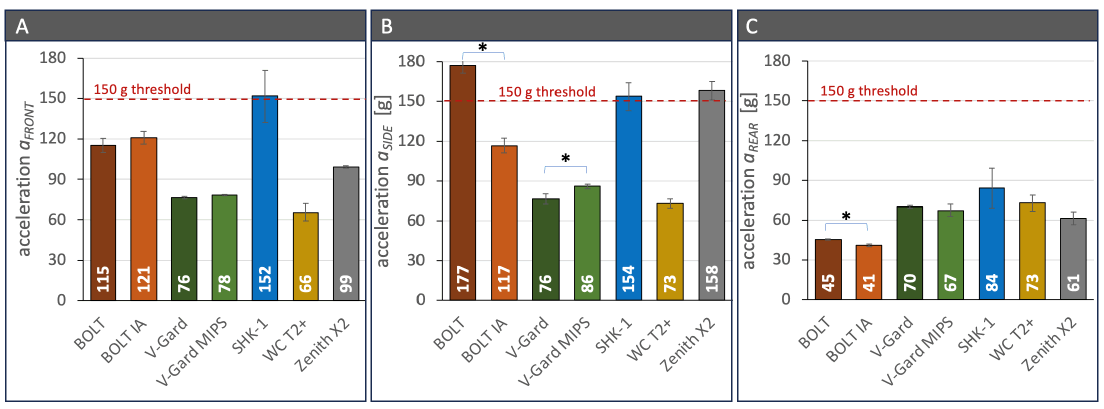
Figure 6: Lateral impact test results shown for, Note: A) Front impacts; B) Side impacts; C) Rear impacts shown in correlation to the 150 g threshold specified in ANSI Z89.*; indicate significant differences between the same helmet model with and without a rotation-damping technology.
Side impacts induced peak linear accelerations aSIDE ranging from 73 ± 3 g for WC T2+ helmets to 177 ± 6 g for BOLT helmets (Figure 6B). Impact Armor technology in the BOLT IA group significantly reduced a SIDE by 34% compared to the BOLT group without the technology (p<0.001). MIPS technology in the V-Gard MIPS group increased aSIDE by 13% compared to the V-Gard group without the technology (p=0.02). The 150 g threshold was exceeded in all three tests of the BOLT group and in two out of three tests in the SHK-1 and Zenith X2 groups.
Rear impacts induced peak linear accelerations aREAR ranging from 41 ± 1 g for BOLT IA helmets to 84 ± 15 g for SHK-1 helmets (Figure 6C). Impact Armor technology in the BOLT IA group significantly reduced aREAR by 9% compared to the BOLT group without the technology (p=0.03). MIPS technology in the V-Gard MIPS group had no significant effect on aREAR compared to the V-Gard group without the technology (p=0.37). All seven helmets remained below the 150 g threshold specified in ANSI Z89.1 (Figure 6).
For crown impact testing representative of a falling object according to standard EN 12492, average impact speeds per group ranged from 6.18 m/s to 6.22 m/s, corresponding to impact energies ECROWN ranging from 95.5 J to 96.7 J, respectively.
Crown impacts induced peak impact forces FCROWN ranging from 5.5 ± 0.2 kN for BOLT IA helmets to 18.1 ± 2.1 kN for Zenith X2 helmets (Figure 7). Impact Armor technology in the BOLT IA group significantly reduced FCROWN by 62% compared to the BOLT group without the technology (p<0.001). MIPS technology in the V-Gard MIPS group had no significant effect on FCROWN compared to the V-Gard group without the technology (p=0.66). Two of the seven helmets (BOLT, Zenith X2) exceeded the 10 kN threshold specified in EN 12492 in all three repeat tests. The remaining five helmets yielded FCROWN values that remained between 33% to 45% below the 10 kN threshold.
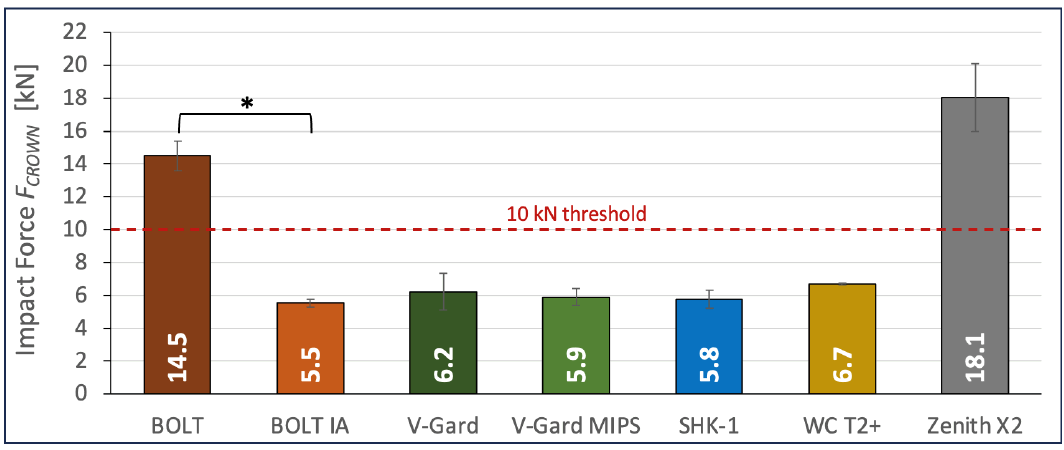
Figure 7: Crown impact forces in correlation to the 10 kN threshold specified in EN 12492. Note: * indicates significant differences between the same helmet model with and without a rotation-damping technology.
For oblique impact testing representative of falls using a Hybrid III head and neck surrogate, there was no significant difference in the average impact speed and energy between groups. Average impact speeds ranged from 6.18 m/s to 6.20 m/s and corresponding impact energies ranged from 273 J to 275 J.
Peak linear accelerations aR in oblique impact testing ranged from 79 ± 11 g for SHK-1 helmets to 114 ± 5 g for Zenith X2 helmets (Figure 8A). Impact Armor technology in the BOLT IA group had no significant effect on aR compared to the BOLT group without the technology (p=0.15). MIPS technology in the V-Gard MIPS group had no significant effect on the peak linear acceleration aR compared to the V-Gard group without the technology (p=0.06).
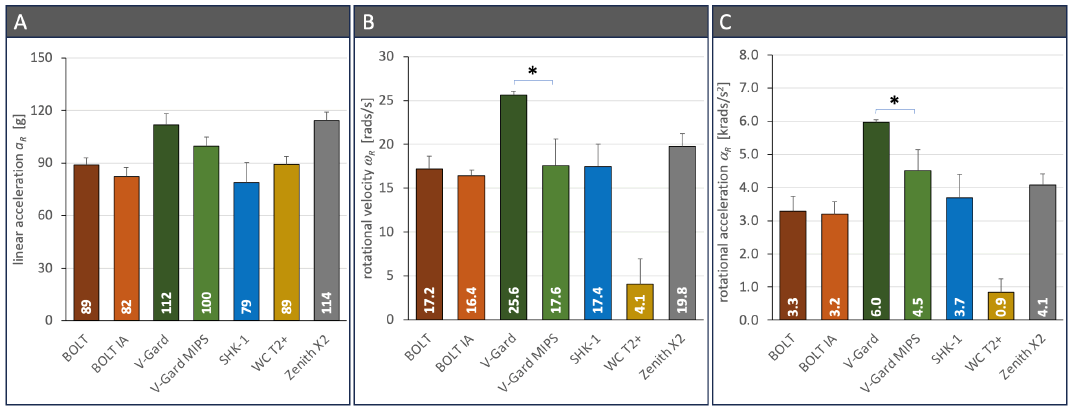
Figure 8: Results of oblique impact testing representative of falls, measured in terms of, Note: A) Peak linear acceleration aR; B) Peak rotational velocity ωR; C) Peak rotational acceleration αR of the headform; * indicates significant differences between the same helmet model with and without a rotation-damping technology.
Peak rotational velocity ωR in oblique impact testing ranged from 4.1 ± 2.9 rads/s for WC T2+ helmets to 25.6 ± 0.5 rads/s for V-Gard helmets (Figure 8B). Impact Armor technology in the BOLT IA group had no significant effect on ωR compared to the BOLT group without the technology (p=0.42). MIPS technology in the V-Gard MIPS group significantly reduced the peak rotational velocity ωR by 31% compared to the V-Gard group without the MIPS technology (p=0.011).
Peak rotational acceleration αR in oblique impact testing ranged from 0.9 ± 0.4 rads/s2 for WC T2+ helmets to 6.0 ± 0.1 rads/s2 for V-Gard helmets (Figure 8C). Impact Armor technology in the BOLT IA group had no significant effect on αR compared to the BOLT group without the technology (p=0.80). MIPS technology in the V-Gard MIPS group significantly reduced the peak rotational velocity αR by 25% compared to the V-Gard group without the MIPS technology (p=0.017) (Figure 8).
Discussion
Results of this study demonstrated that established impact tests can effectively delineate performance differences between helmet models to inform selection and further improvement of safety helmets. Given todays unprecedented variety of helmet models and new helmet technologies that are promoted by manufacturers’ claims, such numerical evidence from physical tests is critical to identify head protection that holds the best potential to reduce the incident and severity of head injury.
The need for Type II lateral protection was emphasized as early as 1987 in a study by Gilchrist and Mills, concluding that Type I helmets are practically useless against side, front and rear impacts, making a redesign necessary [36]. Lateral impact performance matters in real-world accidents since 52%-62% of impacts occur to the helmet front and sides and only 25%-33% of impacts occur on the helmet crown [37]. The 150 g threshold for lateral impacts specified by ANSI remains below the average head acceleration of 250 ± 65 g that induced skull fracture by head impacts on a flat steel anvil in a human cadaver study [38]. Given the low drop height of 0.6 m, the ANSI Type II test likely underestimates real-world impact forces during slip, trip and same level fall events. In a 2023 study, all seven climbing-style safety helmets failed this Type II criterion, exhibiting head accelerations of up to 260 g, 266 g and 209 g in front, side and rear impacts, respectively [19]. In comparison, the seven Type II helmets of the present study demonstrated a drastic improvement by exhibiting maximal head accelerations of 152 g, 177 g and 84 g in front, side and rear impacts, respectively. Rear impacts yielded on average 38% and 48% lower impact accelerations than front and side impacts, respectively, likely because of the extended coverage of safety helmets at the back. Conversely, deficient coverage of impact liners may be responsible for the unexpected finding of the present study that the 150 g threshold was exceeded by one helmet model during front impacts and by three helmet models during side impacts. At the front, impact liners of some helmets were gradually tapering to accommodate a close-fitting helmet shape. At the sides, some helmets tapered or eliminated a portion of the impact liner to accommodate internal hardware for fixation and adjustment of the fit system. Most helmet manufacturers share certificates of compliance with standards provided by external test laboratories. The unexpected finding of elevated lateral impact results in ANSI Type II certified helmets might be attributed to several factors. First, the ANSI standard requires helmets to be preconditioned to be either hot (49°C), cold (-18°C), or wet (room temperature), while the present study tested helmets only in dry condition at room temperature. However, testing in the hot condition may soften the helmet shell and possibly elevate impact accelerations. Second, ANSI Z89.1 specifies that helmets should be mounted on the headform in a “normal wearing position”, without specifying how high the front brim should be positioned over the eyebrows. Tilting a helmet closer toward the eyebrows will shift the DTL and associated impact location upwards where tapered impact liners tend to be thicker. Finally, choosing a different side impact location could have drastically lowered acceleration results. However, the selected side impact location complied with the ANSI standard and followed its instruction that the helmet shall be impacted directly over internal projections inside the helmet above the DTL.
By providing an extra layer of impact foam, Impact Armor significantly reduced linear acceleration during side and rear impacts. BOLT IA helmets comfortably passed the Type II threshold in all tests. MIPS did not improve absorption of lateral impacts, likely because the thin slip liner is specifically designed to absorb rotational forces and not linear impact forces. Nevertheless, V-Gard helmets passed the Type II threshold by a wide margin with or without MIPS technology.
Force transmission results in response to crown impact testing varied greatly between helmet models. Five of the seven helmets remained 33%-45% below the 10 kN threshold. Two helmets exceeded the threshold by 45%-81%, whereby elevated force transmission results were likely caused by the helmet shell bottoming out against the crown of the headform. The 10 kN impact force threshold is somewhat higher than the average impact force of 8.4 ± 3.8 kN reported in a full-body human cadaveric study that induced skull fracture by head impacts on a flat steel anvil [37]. Impact Armor reduced the crown impact force by 62% compared to BOLT helmets without Impact Armor, yielding a force transmission value well below the threshold for skull fracture. Since impact-stiffening foam is typically affected by temperature and humidity, the improved performance of BOLT IA helmets should be confirmed after cold and wet preconditioning. Impact force transmission was not significantly affected by the MIPS liner, whereby the impact force values for V-Gard and V-Gard MIPS helmets differed on average by less than 5%. Only one of the seven helmets tested was fully EN 12492 certified. The remaining helmets stated compliance with EN 12492 clauses 4.2.1.2, 4.2.1.3 and 4.2.1.4 for energy absorption in front, side and rear impacts, respectively, but excluded clause 4.2.1.1 for crown energy absorption.
Oblique impact testing results representative of slips, trips and falls may provide the most relevant performance evaluation as it simulates the most frequent cause of work-related head injury [13] and accounts for the rotational forces that are the principal cause of brain injury [7-12]. Despite the high energy of 274 J in these oblique impacts, linear acceleration remained well below the 150 g ANSI threshold from lateral impacts that are conducted at an 8-times lower impact energy of 31 J. This suggests that in oblique impacts a considerable amount of impact energy is transferred from linear forces into rotational forces. Neither the Impact Armor nor the MIPS liner had a significant effect on the linear acceleration. However, the MIPS liner proved efficient in absorbing rotational force transmission to the head, as evident by a 31% reduced rotational velocity and a 25% reduced rotational acceleration compared to the same helmet without MIPS liner. In contrast, the Impact Armor foam had no effect on rotational velocity or acceleration, suggesting that it has limited potential to reduce rotational force transmission to the brain. In-house testing by the manufacturer of Impact Armor simulated oblique impacts with the Hybrid III head neck surrogate at 6.5 m/s onto a 45° angled flat anvil with 211 J impact energy. They advertise a 13% reduction in rotational acceleration from 9.2 rads/s2 to 8.0 rads/s2 for BOLT helmets with Impact Armor compared to BOLT helmets without Impact Armor. In the absence of a formal study protocol, it is however difficult to compare their findings with the results of the present study. The lowest values for rotational velocity, 4.1 ± 2.9 rads/s and rotational acceleration, 0.9 ± 0.4 rads/s2, were obtained with WaveCel T2+ helmets. Their ability to mitigate transmission of rotational forces may be attributed to the combined effects of the cellular material folding on itself and translating inside the helmet to further absorb rotational forces. These results of WC T2+ helmets are somewhat improved compared to results of bicycle helmet prototypes with WaveCel technology that were tested under identical oblique impact conditions, yielding a peak rotational velocity of 5.0 ± 3.5 rads/s and a peak rotational acceleration of 1.9 ± 0.6 rads/s2. Improved performance may be attributed to the hard spherical shell of safety helmets that provides an ideal surface for the spherical WaveCel dome to translating during impact [16].
Results of this study described relative performance differences between seven safety helmet models, tested in three distinct impact scenarios that represent impacts from falling objects and falls. Results are therefore limited to these specific study parameters and may not be extrapolated outside the tested parameter range. The test setup and parameters were selected to align as much as possible with standardized test methods, including the impact energy attenuation test of ANSI Z89.1 and the impact shock absorption test of EN 12492 to facilitate reproducibility between test laboratories. This study only evaluated a subset of performance tests required by ANSI Z89.1 and EN 12492 at ambient room temperature. Furthermore, each helmet in this study was subjected to three lateral impacts (front, side and rear) and one crown impact. Subjecting a helmet to multiple impacts is consistent with test schedules in ANSI 89.1 and impact locations remained sufficiently separated to prevent adverse effects from prior impacts. Furthermore, lateral impacts were conducted before crown impact since they required less impact energy. For oblique impact testing, controversy remains if it should be conducted with a Hybrid III neck surrogate or with an unconstrained headform [10,16,21-24,28-31,39-44]. There are biofidelity limitations of the Hybrid III neck surrogate, which was developed for automotive crash testing and not for helmet impact testing [45]. It was validated in flexion and extension, but has been shown to be overly stiff in lateral bending for which reason only frontal impacts were tested in the present study [46]. Specifically, a mid-sagittal, frontal impact location was chosen to achieve predominantly flexion and extension motion for which the Hybrid III neck has been validated and to match the impact scenarios in previously published studies [23,24,26,43,47]. Most importantly, the weight of the head, neck and drop assembly better represents the actual weight of the head, neck and upper torso in real-world falls compared to impact simulations that omit the neck and only employ a headform [15,48]. Further testing of additional helmet models and emerging helmet technologies will be required to support the evidence-based improvement of head protection.
Conclusion
Helmets are the most effective strategy to reduce the incidence and severity of work-related head injury. Given the market-driven promotion of new helmet models and technologies, test data are essential to objectively guide safety officers and helmet developers toward the most effective helmet designs.
Results of this study demonstrate that the most recent generation of Type II safety helmets provides better protection from lateral impacts than the previous generation of Type I safety helmets. However, performance differences between these latest Type II helmet models persist and should be further evaluated to inform helmet selection and optimization. Moreover, since crown impact performance varied greatly between helmet models, safety officers seeking the best head protection should select helmets that are Type II rated and fully compliant with EN 12492. Furthermore, results of this study demonstrate the significant potential of some rotation damping technologies in reducing transmission of rotational forces to the brain, which holds the prospect to reduce the incidence and severity of work-related TBI. More research and testing will be required to ensure that investment in improved head protection is supported by data-driven evidence.
Funding
This research has been supported by the Research Foundation of Legacy Health System, a not-for-profit hospital group.
Acknowledgement
All co-authors have approved the submitted manuscript. Michael Bottlang contributed to the study conception, conduct and manuscript preparation. Stanley Tsai contributed to the experimental test setup and testing, Tristan Miller contributed to the specimen preparation and testing. Steven Madey contributed to the study conception and result interpretation.
References
- Konda S, Reichard A, Tiesman HM, Hendricks S. Non-fatal work-related traumatic brain injuries treated in US hospital emergency departments, 1998-2007. Inj Prev. 2015;21(2):115-120.
[Crossref] [Google Scholar] [PubMed]
- Watkin C, Phillips J, Radford K. What is a 'return to work' following traumatic brain injury? Analysis of work outcomes 12 months post TBI. Brain Inj. 2020;34(1):68-77.
[Crossref] [Google Scholar] [PubMed]
- Fu TS, Jing R, McFaull SR, Cusimano MD. Health & economic burden of traumatic brain injury in the Emergency Department. Can J Neurol Sci. 2016;43(2):238-247.
[Crossref] [Google Scholar] [PubMed]
- Tiesman HM, Konda S, Bell JL. The epidemiology of fatal occupational traumatic brain injury in the U.S. Am J Prev Med. 2011;41(1):61-67.
[Crossref] [Google Scholar] [PubMed]
- CEN ECfS. Mountaineering equipment-Helmets for mountaineer-Safety requirements and test methods. In: EN 12492. Brussels. 2012.
- ISEA. Z89.1-2014 American national standard for industrial head protection. In: American National Standards Institute ANSI, Arlington, Virginia. 2014.
- Gennarelli TA. Mechanisms of brain injury. J Emerg Med. 1993;11(S1):5-11.
[Google Scholar] [PubMed]
- Gutierrez E, Huang Y, Haglid K, Bao F, Hansson HA, Hamberger A, et al. A new model for diffuse brain injury by rotational acceleration: I model, gross appearance, and astrocytosis. J Neurotrauma. 2001;18(3):247-257.
[Crossref] [Google Scholar] [PubMed]
- King AI, Ruan JS, Zhou C, Hardy WN, Khalil TB. Recent advances in biomechanics of brain injury research: A review. J Neurotrauma. 1995;12(4):651-658.
[Crossref] [Google Scholar] [PubMed]
- Post A, Blaine Hoshizaki T. Rotational acceleration, brain tissue strain, and the relationship to concussion. J Biomech Eng. 2015;137(3):030801.
[Crossref] [Google Scholar] [PubMed]
- Rowson S, Duma SM. Brain injury prediction: Assessing the combined probability of concussion using linear and rotational head acceleration. Ann Biomed Eng. 2013;41(5):873-882.
[Crossref] [Google Scholar] [PubMed]
- Gallant T. Can safety helmets protect against dangerous rotational forces? Occupational Health and Safety. 2022;91(3):38-39.
- US Occupational safety and health administration. Severe injury reports. In: Data from 1/1/2015 through 3/31/2021. 2021.
- Munoz-Sanchez MA, Murillo-Cabezas F, Cayuela-Dominguez A, Rincon-Ferrari MD, Amaya-Villar R, Leon-Carrion J. Skull fracture, with or without clinical signs, in mTBI is an independent risk marker for neurosurgically relevant intracranial lesion: A cohort study. Brain Inj. 2009;23(1):39-44.
[Crossref] [Google Scholar] [PubMed]
- Bland ML, McNally C, Rowson S. Headform and neck effects on dynamic response in bicycle helmet oblique impact testing. In: International Research Council on the Biomechanics of Impact (IRCOBI). Athens, Greece. 2018.
- Bliven E, Rouhier A, Tsai S, Willinger R, Bourdet N, Deck C, et al. Evaluation of a novel bicycle helmet concept in oblique impact testing. Accid Anal Prev. 2019;124:58-65.
[Crossref] [Google Scholar] [PubMed]
- Bottlang M, DiGiacomo G, Tsai S, Madey S. Effect of helmet design on impact performance of industrial safety helmets. Heliyon. 2022;8(8):e09962.
[Crossref] [Google Scholar] [PubMed]
- Chung VWJ, Dias L, Booth G, Cripton PA. Incorporating neck biomechanics in helmet testing: Evaluation of commercially available WaveCel helmets. Clin Biomech (Bristol, Avon). 2022;94:105628.
[Crossref] [Google Scholar] [PubMed]
- Bottlang M, Hodgson VR, Tsai S, Madey S. Climbing style safety helmets do not improve impact protection over type II hard hats. Safety Science. 2023;168:1-8.
- Pardon M. Why the switch to safety helmets is a good decision. Occupational Health and Safety. 2022;91(6):88-92.
- Bottlang M, Rouhier A, Tsai S, Gregoire J, Madey SM. Impact performance comparison of advanced bicycle helmets with dedicated rotation-damping systems. Ann Biomed Eng. 2020;48(1):68-78.
[Crossref] [Google Scholar] [PubMed]
- DiGiacomo G, Tsai S, Bottlang M. Impact performance comparison of advanced snow sport helmets with dedicated rotation-damping systems. Ann Biomed Eng. 2021;49(10):2805-2813.
[Crossref] [Google Scholar] [PubMed]
- Hansen K, Dau N, Feist F, Deck C, Willinger R, Madey SM, et al. Angular Impact Mitigation system for bicycle helmets to reduce head acceleration and risk of traumatic brain injury. Accid Anal Prev. 2013;59:109-117.
[Crossref] [Google Scholar] [PubMed]
- Finan JD, Nightingale RW, Myers BS. The influence of reduced friction on head injury metrics in helmeted head impacts. Traffic Inj Prev. 2008;9(5):483-488.
[Crossref] [Google Scholar] [PubMed]
- Fredriksson R, Zhang L, Bostrom O, Yang K. Influence of impact speed on head and brain injury outcome in vulnerable road user impacts to the car hood. Stapp Car Crash J. 2007;51:155-167.
[Crossref] [Google Scholar] [PubMed]
- Ivarsson J, Viano DC, Lovsund P, Parnaik Y. Head kinematics in mini-sled tests of foam padding: relevance of linear responses from Free Motion Headform (FMH) testing to head angular responses. J Biomech Eng. 2003;125(4):523-532.
[Crossref] [Google Scholar] [PubMed]
- Trotta A, Ni Annaidh A, Burek RO, Pelgrims B, Ivens J. Evaluation of the head-helmet sliding properties in an impact test. J Biomech. 2018;75:28-34.
[Crossref] [Google Scholar] [PubMed]
- Allison MA, Kang YS, Bolte JHt, Maltese MR, Arbogast KB. Validation of a helmet-based system to measure head impact biomechanics in ice hockey. Med Sci Sports Exerc. 2014;46(1):115-123.
[Google Scholar] [PubMed]
- Bland ML, McNally C, Zuby DS, Mueller BC, Rowson S. Development of the STAR evaluation system for assessing bicycle helmet protective performance. Ann Biomed Eng. 2020;48(1):47-57.
[Crossref] [Google Scholar] [PubMed]
- Jadischke R, Viano DC, McCarthy J, King AI. The Effects of helmet weight on hybrid iii head and neck responses by comparing unhelmeted and helmeted impacts. J Biomech Eng. 2016;138(10).
[Crossref] [Google Scholar] [PubMed]
- Viano DC, Withnall C, Halstead D. Impact performance of modern football helmets. Ann Biomed Eng. 2012;40(1):160-174.
[Crossref] [Google Scholar] [PubMed]
- United National Economic Commission for Europe. Uniform provisions concerning the approval of protective helmets and their visors for drivers and passengers of motorcycles and modes. United Nations Economic Commission for Europe 1999; Genega, Switzerland (Standard No. R-22.05).
- American National Standards Institute (ASTM). Standard Specifications for Protective Headgear Used in Horse Sports and Horseback Riding. In: ASTM F1163-15. West Conshohocken, PA: ASTM International; 2015.
- Consumer Product Safety Commission (CPSC). Safety Standard for Bicycle Helmets. In: 16 CFR Part 1203: Federal Register; 1998. pp. 11711-11747.
- SAE. Instrumentation for impact test. Part 1. Electronic Instrumentation (SAE J21101). Society of Automotive Engineers. 2007.
- Gilchrist A, Mills NJ. Construction site workers helmets. J Occup Accid. 1987;9(3):199-211.
[Crossref] [Google Scholar] (All versions)
- Proctor TD, Rowland FJ. Development of standards for industrial safety helmets-The state of the art. J Occup Accid. 1986;8(3):181-191.
- Yoganandan N, Pintar FA. Biomechanics of temporo-parietal skull fracture. Clin Biomech (Bristol, Avon). 2004;19(3):225-239.
[Crossref] [Google Scholar] [PubMed]
- Bartsch A, Benzel E, Miele V, Morr D, Prakash V. Hybrid III Anthropomorphic Test Device (ATD) response to head impacts and potential implications for athletic headgear testing. Accid Anal Prev. 2012;48:285-291.
[Crossref] [Google Scholar] [PubMed]
- Bland ML, McNally C, Rowson S. Differences in impact performance of bicycle helmets during oblique impacts. J Biomech Eng. 2018;140(9).
[Crossref] [Google Scholar] [PubMed]
- McIntosh AS, Lai A, Schilter E. Bicycle helmets: Head impact dynamics in helmeted and unhelmeted oblique impact tests. Traffic Inj Prev. 2013;14(5):501-508.
[Crossref] [Google Scholar] [PubMed]
- Klug C, Feist F, Tomasch E. Testing of bicycle helmets for preadolescents. In: International Research Council on the Biomechanics of Injury (IRCOBI). Lyon, France; 2015. pp. 136-155.
- Mills NJ, Gilchrist A. Oblique impact testing of bicycle helmets. Int J Impact Eng. 2008;35(9):1075-1086.
- Milne G, Deck C, Bourdet N, Carreira RP, Allinne Q, Gallego A, et al. Bicycle helmet modelling and validation under linear and tangential impacts. Int J Crashworthiness. 2013;1-11.
- MacGillivray S, Wynn G, Ogle M, Shore J, Carey JP, Dennison CR. Repeatability and biofidelity of a physical surrogate neck model fit to a hybrid III head. Ann Biomed Eng. 2021;49(10):2957-2972.
[Crossref] [Google Scholar] [PubMed]
- Sances A, Jr, Carlin F, Kumaresan S. Biomechanical analysis of head-neck force in hybrid III dummy during inverted vertical drops. Biomed Sci Instrum. 2002;38:459-464.
[Google Scholar] [PubMed]
- Aare M, Halldin P. A new laboratory rig for evaluating helmets subject to oblique impacts. Traffic Inj Prev. 2003;4(3):240-248.
[Crossref] [Google Scholar] [PubMed]
- Ghajari M, Peldschus S, Galvanetto U, Iannucci L. Effects of the presence of the body in helmet oblique impacts. Accid Anal Prev. 2013;50:263-271.
[Crossref] [Google Scholar] [PubMed]
Citation: Bottlang M, Tsai S, Miller T, Madey S (2024). Impact Performance Comparison of Type II Safety Helmets with and without Dedicated Mechanisms for Brain Protection. J Forensic Biomech. 15:490.
Copyright: © 2024 Bottlang M, et al. This is an open-access article distributed under the terms of the Creative Commons Attribution License, which permits unrestricted use, distribution, and reproduction in any medium, provided the original author and source are credited.
